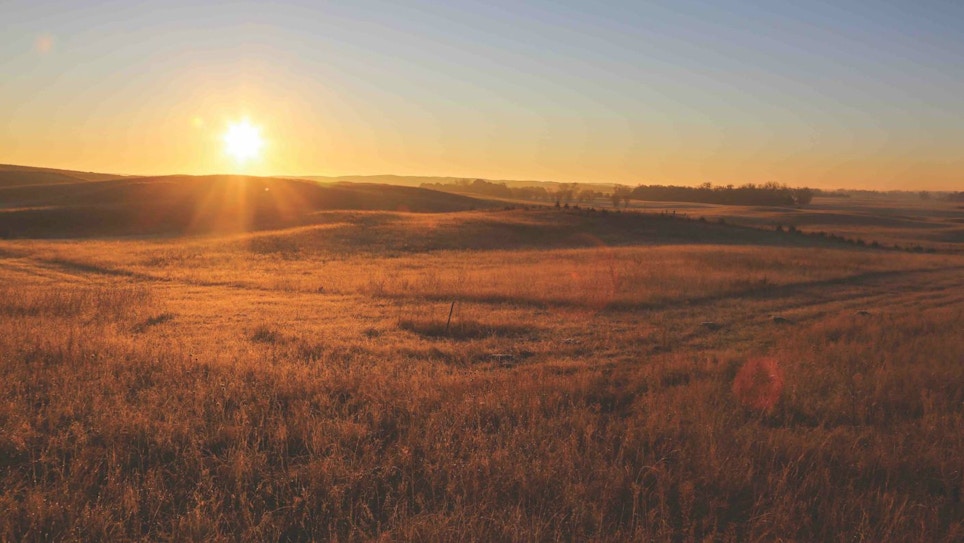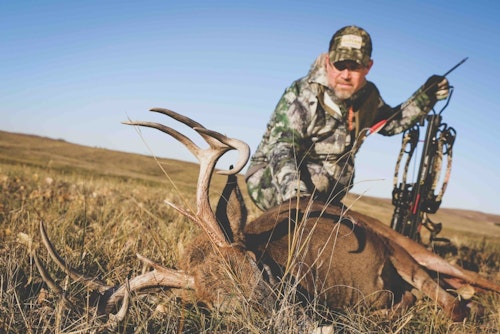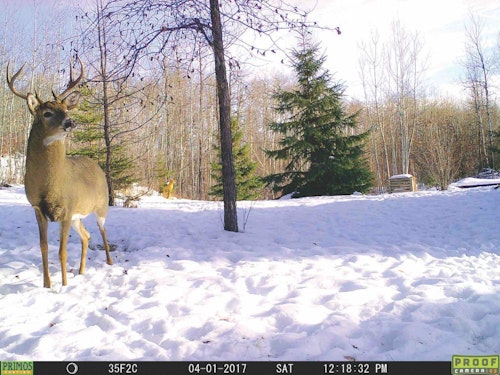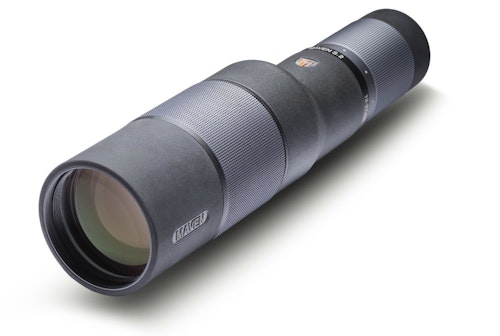
Post-season glassing near sunset helps identify mature bucks that successfully avoided deer hunters. Use a spotting scope or high-magnification bino to avoid alerting the animals.
I do most of my deer hunting on my own and consider myself knowledgeable when it comes to sorting out the details to find a big whitetail, but there’s always more to learn. One of the best hunters I’ve ever hunted with is Ralph Dampman from Trophy Ridge Outfitters in Wyoming. To say Ralph has intimate knowledge of his deer would be an understatement.
In one trip to Wyoming, the biggest thing I learned from Ralph is to hunt all year. As part of his job, he takes a drive every day to watch and check the deer in his area. He knows their seasonal patterns and food preferences, as well as which habitats see some migration and movement at different times of the year. If the wind changes direction, Ralph knows exactly what the deer will do and where they’ll travel. The hours of homework he puts in provides the details that make him successful. The first time I bowhunted whitetails with Ralph, there were six hunters in camp, and everyone was tagged out with exceptional bucks in only two days.
Like Ralph, the most successful bowhunters are well-versed with their quarry, paying close attention to their seasonal habitats and patterns. Data collected over a year-in-the-life — the day after deer season until opening day — of a bowhunter provides critical information to increase success. If you want to be more successful next season, continue reading.
Post-Rut Data
One of my favorite times of year to keep tabs on big bucks is right after the rut, and in most cases, after the hunting season. The bucks that made it through the season are the ones I will be targeting, if I hunt the same area. There is always a chance a new buck will move in, but in most cases, deer will use the same home range they have used in previous years. The only exception is when habitat is altered, or new food sources change a deer’s perspective as to where it wants to live.
Post-season bucks tend to let their guard down —at least a little — focusing on rebuilding reserves lost to the rut, meaning they are focused on groceries. Spotting sessions after the season will provide insight into big deer that survived to be pursued another year.
Deer tend to congregate in areas with the best feed, making it easier to pinpoint deer when watching from a distance. When the deer season closes, I’m usually exhausted from hunting at a frantic pace, but the days are short and getting out to collect some deer intel is the best way to unwind from a busy hunting season.
Trail Cameras
The development of the trail camera must be the single biggest tool that has allowed hunters to keep an eye on deer without being there in person. It wasn’t many years ago that we looked at the size of tracks and rubs to decide if a big buck was in the area. Today, hunters have photos and video of most deer in their hunting area.
Compiling information from trail cameras can unveil patterns and seasonal movement of bucks. With changing crops from year to year, a hunter can predict movements by checking trail camera data from previous years to see what deer did when a specific crop was planted in a field.
Cameras with data plans will send images directly to your cell phone as they are taken. The time of day, quality of antlers and other intel can be collected throughout the year. Set the time and date stamp on all photos to learn more about deer movements. You can tie changes in movement to other data collected, and then use the information in the fall.
Moon Phase
The moon plays a complex role in deer movement. Logging information on the times deer move under different moon phases and illumination will be enlightening. When I see deer feeding or moving during the day, I always check the moon phase, as it tells me what conditions and circumstances I need during the hunting months to see more deer during legal shooting hours.
The gravitational pull of the moon does strange things to the ocean tides and wildlife in general. When you start paying attention to the moon and animal movement throughout the year, you soon see patterns that could increase your success as a hunter.
Have you ever watched deer under a full moon? Some of my best spotting missions have been at night when I can park in a good location and watch deer with binocular or spotting scope. Spotting by moonlight is also the ultimate test for your optics and the detail you can see. Good optics will allow you to count points on an antler and judge mass. It is an exciting way to see more deer and get a glimpse at some of the big boys that live a shy and secluded life.
Shed Hunting
Late winter and early spring are the time to hunt for shed antlers. Active food sources and game trails in travel corridors are always hotspots. Finding the shed of a big buck deserves scrutiny. Where did you find it? The exact spot it was dropped can tell you a lot about the deer. Where it prefers to move or feed can be determined by shed location. If you find the second one in the area, you can start tying clues together. Finding the sheds of the same deer year after year is powerful information and should help pin down a buck’s home range or comfort zone.
Sheds also tell you the trophy quality that exists in your herd. Long beams, tall tines and overall mass speak to genetics and age. Not all hunting areas have great genetics and sometimes what you learn means changing hunting locations altogether.
Green Up
When spring finally arrives, deer hit the fields as they are greening up. Antlers have usually been dropped, but it isn’t hard to decipher bucks from does and where they like to feed. Spring mapping of agricultural fields aids to identify the best food sources for deer in the area. A completed map will dictate where to place stands and blinds later in the summer. Preferred feed changes regionally, and what you’ve learned by watching deer should tell you what crops they will key in on at different times of the growing season, and after harvest.
Having access to an aerial view of agricultural fields and habitat makes it easier to determine where deer will be moving and traveling to get their groceries. As crops grow, it is important to pay attention to deer movement under different weather conditions, too. Where do deer access fields when the wind changes direction? What do they do in the rain? The more details you can learn during the growing season, the easier it is to set up and be successful when the bow season comes along.
Keep Watch
It may sound simple enough, but most hunters do not spend enough time watching deer regularly. Where do the does come out of cover and where do the bucks tend to hang out? Knowing this ahead of deer season will allow for effective stand placement with provisions to hunt under any weather conditions.
Good optics allow you to watch from a distance, leaving deer undisturbed. A spotting scope allows you to watch distant trails and pick apart tree cover to find bucks. It often takes days to pattern a deer and watch it to find out where it is coming from and where it is headed. The daily routine of a buck or bachelor group is golden to a deer hunter. Detailed intel about deer movement is what hunters pay for when using an outfitter, but it’s possible to duplicate the success at home by spending more time watching your deer.
Watching antler growth from the early stages to hard, polished tines can be an eye-opener. Deer can grow antler at an exceptional rate, and it doesn’t take long to determine which bucks you’ll want to target as soon as the season opens.
Rain and Tracks
Rainy days are a favorite for finding new tracks and areas where deer are moving. Wet days provide information on deer you aren’t seeing. Where are they moving, where are they entering fields? This can be especially helpful with stand selection.
Identify New Ambushes
Collecting data all year makes placement of stands and blinds easier. A month ahead of deer season, set stands and/or blinds for as many wind and weather conditions as possible. Setting up ambushes early ensures leftover scent isn’t lingering, and whitetails will have time to get accustomed to new encroachments on their home turf.
Ensuring there are options for different wind conditions and always remaining incognito provides confidence. This is a good time to find exit routes that are less likely to spook or educate deer. The last thing you want is to change the daily routine of a deer herd after sitting in the stand the first night.

Scout It
Scouting all year is really hunting every month of the calendar. The things you see and learn make you an expert in your area. Time is always a premium, but spending time in the outdoors is a healthy choice that you can share with family and good friends. If you’re still wondering when you should start scouting for next year, I recommend the day after the deer season closes.
Sidebar: HuntStand App
HuntStand is a unique app that allows a hunter to map out entire hunting areas. You can delineate boundaries, set markers for rubs, scrapes, harvest sites, stands and much more. Additionally, you can share information with friends and continue to add layers of information. The app allows you to manage trail camera photos and store them for specific locations. Map overlays allow you to look at private and public lands, satellite views, hydrology and much more. All of these come together to provide valuable tools that will help identify likely deer bedding cover, travel routes and food sources.
HuntStand is a free download and offers in-app purchases for things such as land ownership overlays. For more information, go to www.huntstand.com.
Sidebar: Maven S.2 Compact Spotting Scope
Maven Optics has been growing in popularity, producing crisp, clear optics that work well in low-light conditions, even spotting by moonlight. The Maven S.2. is compact and lightweight at just 34 ounces and measuring 11 inches. The scope features a 12-27x magnification range with a 56mm objective lens. Its light weight comes with the magnesium/polymer frame, and the crisp images come from an Abbe-Koenig prism and crystal-clear fluorite objective lens. To top it off, Maven offers a lifetime warranty. For more information: www.mavenbuilt.com.










